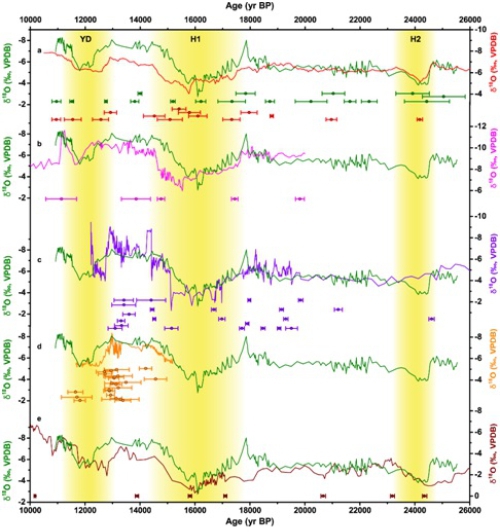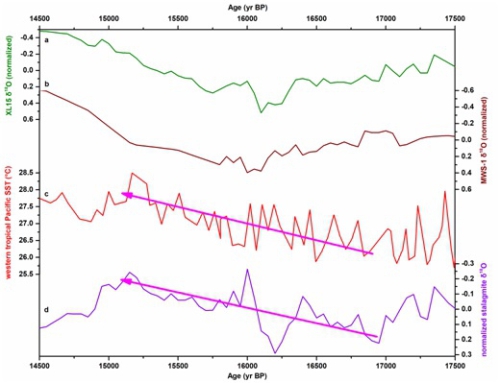
As a unique continental archive, speleothem has been widely used in reconstructing paleoclimate change. However, the interpretation of Chinese speleothems δ18O has remained a subject of debate. Is it solely controlled by the Indian summer monsoon (ISM)?
To answer this question, a research team led by Prof. TAN Liangcheng from the Institute of Earth Environment (IEE) of the Chinese Academy of Sciences analyzed variations in stalagmite δ18O (XL15) from Xianglong cave during 25.5-10.9 ka BP. Their findings were published in Climate Dynamics.
The results revealed that on millennial scale, the XL15 δ18O record showed similar variations with ice core record from Greenland and other climate records from China and India. It also exhibited negative correlation with δ18O record from the South American summer monsoon region.
This reflected the consistency of the global monsoon. However, when compared the amplitudes of stalagmite δ18O of XL15 record with those from India during Heinrich events, a weakened δ18O signal from India to eastern China was not seen as simulated by model (Pausata et al. 2011).
Moreover, Chinese stalagmite δ18O records showed three-stages (increasing-stable-increasing) in mutation mode of Heinrich1 (H1) event. In contrast, Indian stalagmite δ18O records showed consistent increasing mode. In addition, the differences between stalagmite records from eastern China and the ISM region were observed on glacial-interglacial scale and decadal scales, which indicated the influence of Pacific on Chinese Stalagmite δ18O.
In order to extract the pure Pacific’s signal from XL15 during H1 event, the scientists subtracted the Indian Mawmluh stalagmite δ18O signal (solely controlled by the Indian Ocean) from XL15 record (controlled by both the Indian Ocean and Pacific).
The result was significantly negatively correlated with the Western Pacific Warm Pool (WPWP) sea surface temperature (SST). High SSTs in the WPWP would strengthen the upper convection around the region of Philippine, which would cause the northward shift of the West Pacific Subtropical High and the East Asian summer monsoon (EASM) Meiyu belt, resulting in enhanced rainfall from the single source-Pacific (already exclude the Indian Ocean signal) and negative rainfall δ18O.
All the evidence above suggested that the ISM is not the sole controlling factor of Chinese stalagmite δ18O, and both the ISM and EASM could influence the Chinese stalagmite δ18O signal.

Fig.1 The magnitude comparison of XL15 δ18O record (green) andHulu (red), Songjia (plum), Bittoo (purple), Timta (orange)and Mawmluh (brown) cave records. (Imaged by TAN et. al)

Fig.2 Comparison of (a) normalized XL15 δ18O record, (b) normalized Mawmluh δ18O record, (c) SST record from the westerntropical Pacifc Warm Pool, (d) difference between XL15 and Mawmluh record (normalized). (Imaged by TAN et. al)
This work was supported by the National Key Research and Development Program of China, Shaanxi Science Fund for Distinguished Young Scholars, Youth Innovation Promotion Association and West Light Foundation of Chinese Academy of Sciences.

86-10-68597521 (day)
86-10-68597289 (night)

52 Sanlihe Rd., Xicheng District,
Beijing, China (100864)

